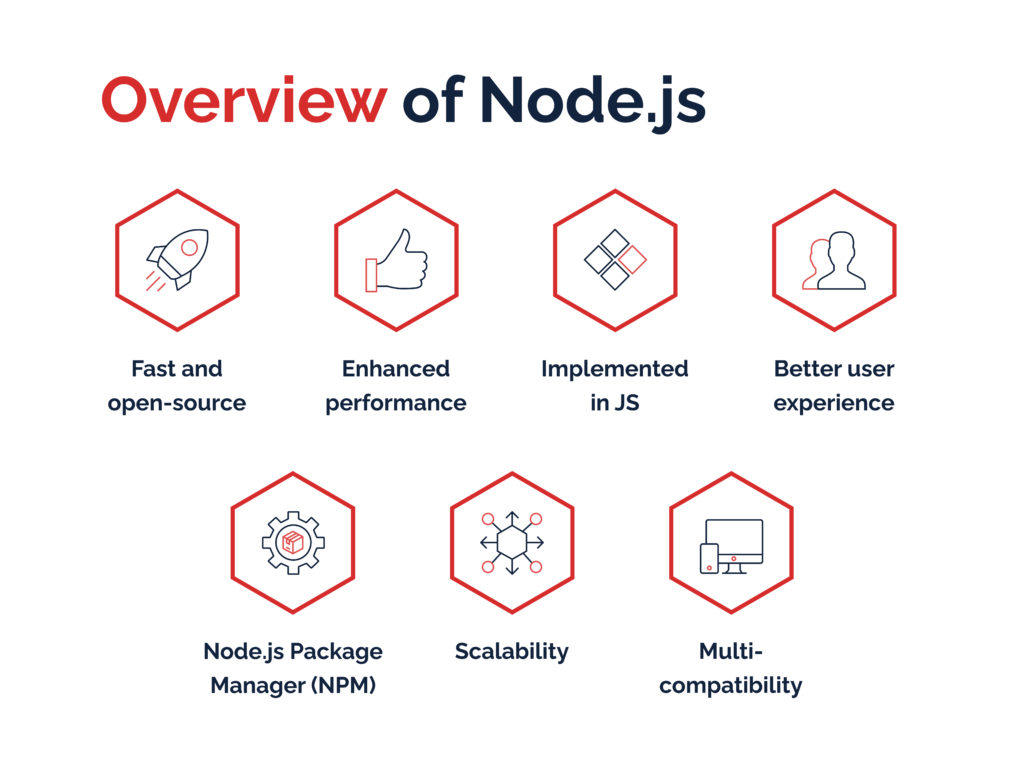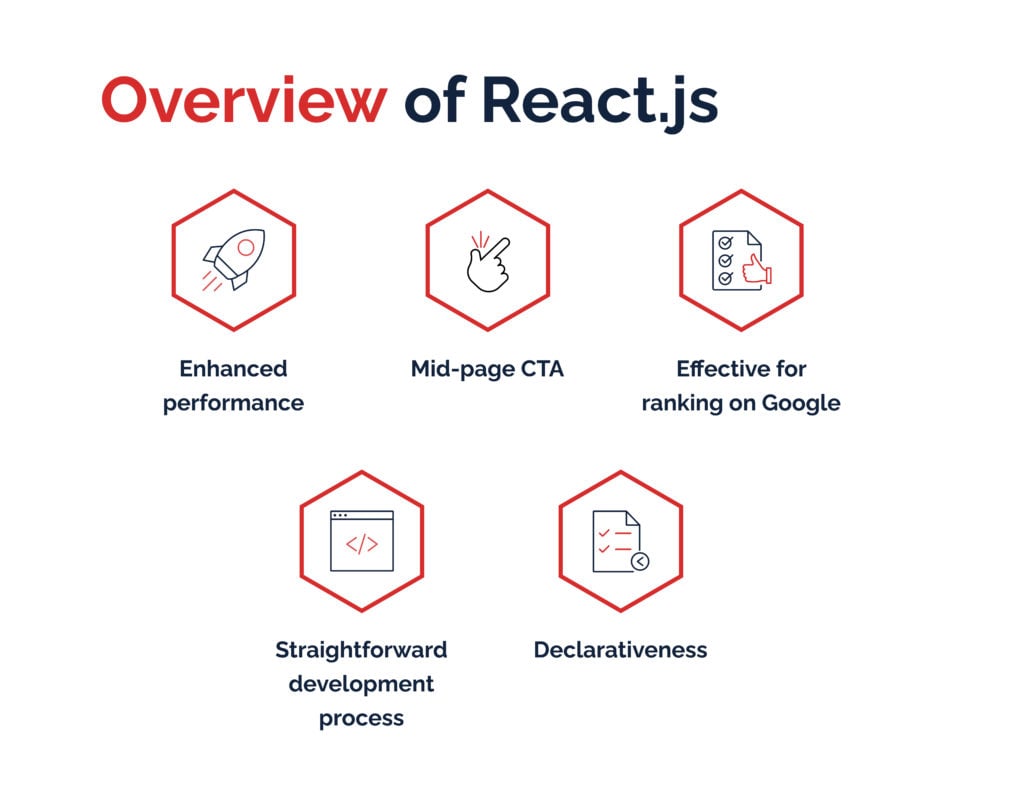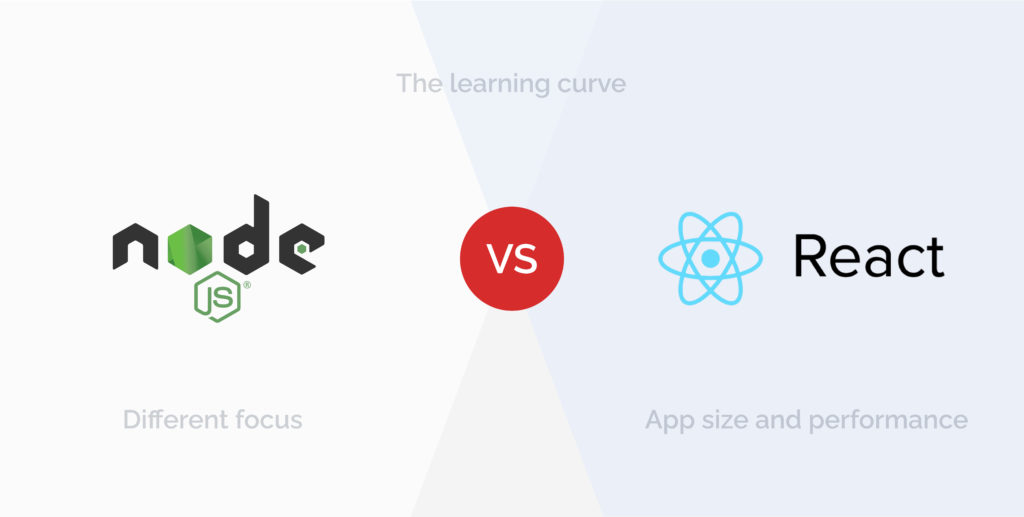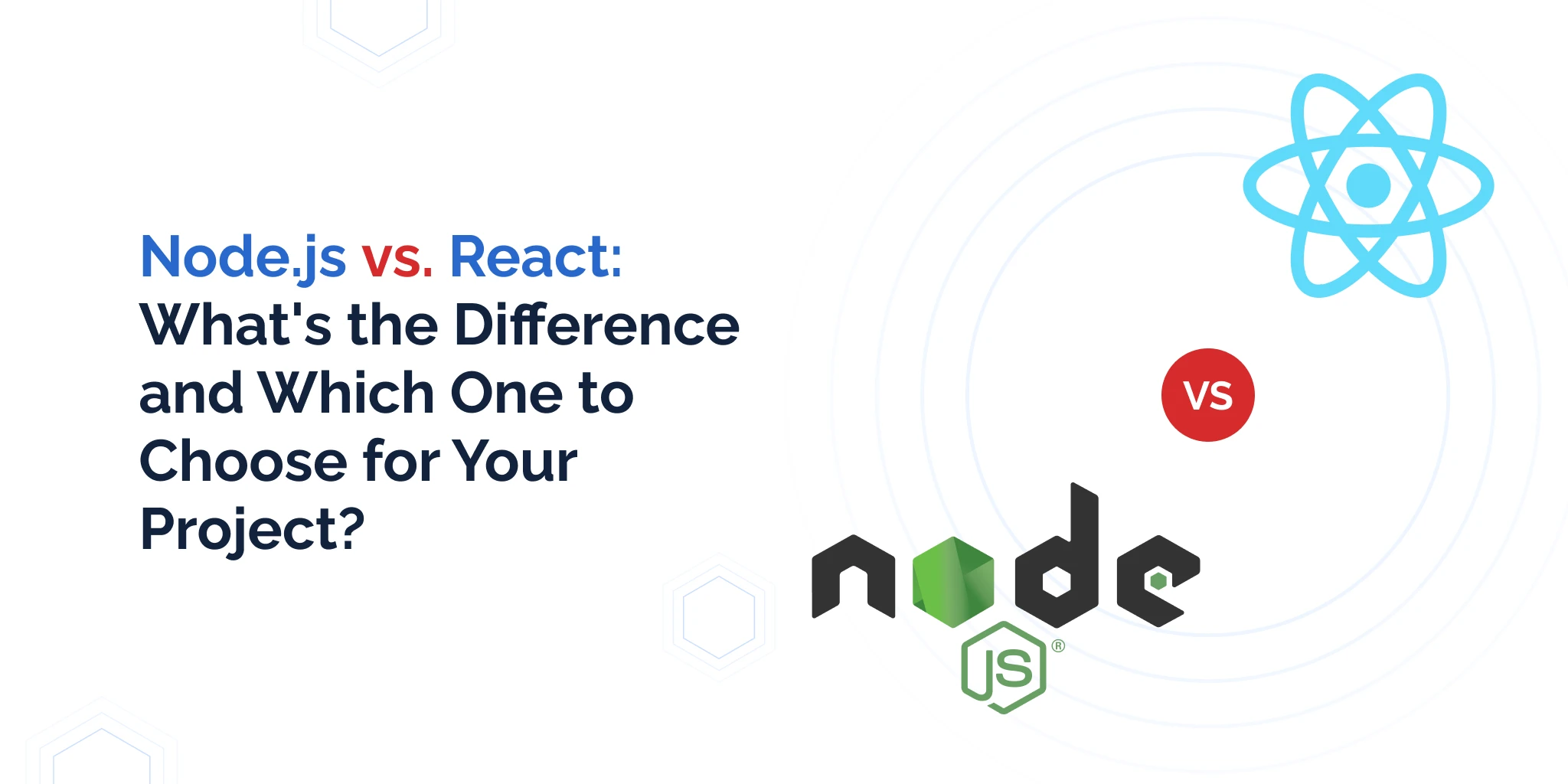Node.js and React are both popular and widely used. The comparison between them isn’t new, but it’s worth attention. The only question is, “Can we compare them?” Let’s start our Node.js vs. React.js review!
At first sight, React.js and Node.js seem similar since both are related to the JavaScript programming language. But is it so? What’s better – a laptop or a smartphone? It’s a weird question, for sure. But comparing the back-end platform and the front-end library is like comparing things mentioned above. This is a point to which the comparison between NodeJS and ReactJS arrives.
So, let’s define their difference. Node.js is a back-end platform for handling server-side operations, while React.js is a front-end library used to manage the user interface. Technically, they’re different and not interchangeable. But we’ll give you a spoiler; they can complement each other in your project.
If you’ve asked yourself at least once, “Which framework should I choose for the project” the article is a partial answer. Here, you’ll better understand the features of Node.js and React.js and set the goals you want to achieve.
Overview of Node.js
One article isn’t enough to describe all the features of Node.js and React as back-end services (Node) and front-end libraries (React), so we’ll focus on the most important ones.
A quick note — when JavaScript came around, it was designed as a simple scripting language to run in a browser and wasn’t prepared as a back-end framework. But the advancement of the web platform made it more powerful, and in 2009 we saw the first release of Node.js. Node.js is a way to write server-side code in JavaScript. In other words, Node.js is the environment for executing your JavaScript code. Previously, only the browser could execute JS code, but now with the help of Node, we can do it outside of a browser.
Node.js is an open-source, cross-platform JS runtime environment for web apps outside the client’s browser. Large companies like PayPal, LinkedIn, Netflix, and Medium use Node.js. An event-driven and non-blocking input/output model makes the platform easy to start and lightweight. Event-driven means you make a call, and the Node.js server gets the request and registers an event. The event will be called when the fetching is completed. So, Node frees the event cycle to perform the next request. Developers use the platform to host APIs, serve HTTP requests, and access the database. Node.js works well for fast and scalable services and server-side apps like video streaming sites, single-page apps, online chatting apps, and others.

Here are the following features of Node.js:
Fast and open-source
Node.js runs on Google’s V8 engine (or Chakra from Microsoft), compiling JS into machine code and making it run efficiently and fast. The open-source opens access to thousands of community-tested software at no cost. But it’s not only about the price. With open-source Node.js, you get flexibility, scalability, and compatibility.
Enhanced performance
Since Node is based on JS, you can use the same language for back-end and front-end development. It enhances the app’s productivity, allowing you to perform non-blocking operations. Well, what does this set of words mean?
Let’s explain the difference between blocking and non-blocking operations. Technically, a blocking call waits for the completion of the input-output operation before returning; its results return synchronously.
In contrast, the non-blocking call returns directly without results, asynchronously. It means you can read files, send emails, query data, and perform other operations simultaneously. You can start the next task before the completion of the previous one.
In our blog, we discuss the pros and cons of Node.js for web app development. Read the article.
Implemented in JS
According to Stack Overflow’s 2020 Developer Survey, JS is the most common language in the world (69.7%). It’s not surprising because, with JavaScript, coders can create dynamic web elements, from clickable buttons to animated graphics. But why do many like Node.js? As Node.js is written in this language, the technology is easier to understand and learn. Also, you use the same language on both the client side in the browser and the server.
Better user experience
The server built with Node.js doesn’t need to wait for data from an API. What’s more, any input/output operation doesn’t block work. As mentioned above, you can perform any action without waiting until the previous task is completed. In Node.js, all operations are performed asynchronously. Thanks to it, Node.js responds quickly and offers a better user experience.
Node.js Package Manager (NPM)
NPM is a package of ready modules. Imagine NPM as a huge room where programmers share their code. It allows new projects to avoid writing the same components.
Scalability
Node.js balances active central processing unit (CPU) cores and provides high customization. The platform handles multiple requests simultaneously with native tools like clusters, child_process, and worker_threads. Even a significant increase in requests doesn’t impact the load on the central processor, making it easy to develop scalable apps.
Multi-compatibility
Node.js is compatible with many systems, from Windows and Mac operating systems to mobile platforms. Multi-compatibility with different platforms creates a self-sufficient environment for developers.
Related services
Who Uses Node.js?
Node.js, a powerful runtime environment for server-side JavaScript, has garnered a diverse user base across the tech industry. One prominent group of users includes web developers who leverage Node.js for building robust server-side apps. Its ability to execute JavaScript code on the server-side enables developers to create server interfaces for website projects with ease. Node.js allows developers to write HTML-like code to handle server-side tasks, providing a familiar syntax for generating dynamic web content.
Another group that embraces Node.js consists of organizations seeking to develop scalable and high-performance web apps. Its ready code modules and rich library of packages make it a compelling choice for rapidly building stable and feature-rich web apps. The Node.js developer community actively contributes to the ecosystem by sharing source code in an open way. Using this approach, it fosters a collaborative environment that encourages innovation and best practices.
Moreover, Node.js is particularly well-suited for handling complex architecture requirements. Its engine power, event-driven architecture, and non-blocking I/O capabilities enable it to efficiently manage concurrent connections and real-time apps. This makes it a preferred choice for organizations dealing with data-intensive and real-time services, such as online gaming platforms and streaming services, where performance and scalability are paramount. In summary, Node.js is a versatile and influential technology, embraced by web developers and organizations for its ability to simplify server-side development and deliver high-performance solutions in various domains.
Overview of React.js
React is an open-source JavaScript library for building web apps, dynamic libraries, and interactive user interfaces which change the image without reloading the page. Thanks to this, the app quickly responds to user actions. React is a library; by default, it doesn’t have routing, web requests, or state management tools. But to manage the above-mentioned, you can install additional libraries required. Well, what makes React so popular?

Enhanced performance
You get enhanced performance thanks to Virtual DOM (Document Object Model), a lightweight version of a real DOM. DOM is a programming interface allowing you to create, modify, or remove elements from a document. The virtual DOM signifies a programming concept where the “virtual” representation of a user interface is stored in memory and synced with the “real” DOM by the library. If we need to change the web page elements, we first make these changes in the virtual DOM. Then, if there’s a difference between the new state of the virtual DOM and the current state, React suggests and executes the needed manipulations to update the real DOM to a new state. The virtual DOM takes up little space and updates quickly, allowing the page to get responses from the server. Thanks to virtual DOM, Facebook updates users’ chats and feeds without reloading the page.
In our blog, we discover the top 8 websites built with React.
Effective for ranking on Google
In combination with Node.js, React renders the code from the server as a regular web page. So it’s easy for the browser to read your app.
Straightforward development process
React has a modular structure for any web app. The development with React.js is centered around the components. You can create components (pieces of code) once and reuse them many times in other apps. With React, you develop complex interfaces from small pieces of code, which we can compare to lego. These components are easy to assemble, reuse, manage, and test. Since they’re reusable with high logic and control, it helps us to work even on large projects, thus keeping the code clean and stable.
Declarativeness
Declarativeness of React is when we use code to say what results we want to display on the page. In the case of declarative programming, we don’t set instructions on how to implement the results.
Related services
Who Uses React.js?
React.js, a frontend library developed and maintained by Facebook, has garnered widespread frontend development application and adoption across the tech industry due to its versatility and effectiveness in frontend development. One of its primary user groups consists of frontend developers who rely on React.js to craft intuitive and dynamic user interfaces for web apps. Whether it’s a small personal project or a large-scale enterprise application, React.js offers the tools and capabilities needed to build responsive and engaging user experiences.
Another significant domain where React.js finds extensive usage is in real-time applications. These include chat apps, online gaming platforms, and collaborative tools, where React’s ability to provide instant updates and smooth user interactions makes it an invaluable choice. Furthermore, client-side applications, such as ecommerce websites and social media platforms, benefit from React.js’s efficient handling of UI components, enhancing the user experience.
React.js’s popularity can also be attributed to its code reusability through a component-based architecture. Developers appreciate the ease with which they can create and reuse code components, saving time and effort in the development process. Additionally, React.js seamlessly integrates with server-side technologies like Node.js. Thus, it allows for the creation of full-stack applications that combine both server-side and client-side capabilities. All this makes the platform a versatile and powerful tool in modern web development.
Ultimately, React.js is a versatile and widely adopted library that has found its place in various sectors of the tech industry. Frontend developers, real-time product creators, and developers of some server-side web application projects all benefit from React’s capabilities in creating dynamic web applications with responsive user interfaces. With its component-based architecture and compatibility with server-side technologies, React.js continues to be a popular choice among developers and organizations seeking to deliver exceptional user experiences in web apps.
Node JS vs. React JS Comparison

Should we call Node.js and React competitors? The answer is no. They’re reasonable solutions for diverse projects but serve different functions. And we’d like to show Node.js vs. React comparison based on the parameters below.
Different focus
In a Node vs. React comparison, Node.js is an open-source platform for writing code and creating back-end web content. React.js is an open-source library for producing high-performance front-end apps. In this case, the similarity between them is that they use JavaScript under the hood.
The learning curve
The learning curve of React.js and Node.js is almost the same, with the only difference. React.js makes web development easy to implement because of well-detailed documentation and simple design. Node.js is also easy to learn, but developing and deploying apps may take more effort because of the asynchronicity of Node.js. But since Node.js increases app productivity and allows you to reprocess the code, it greatly simplifies development.
App size and performance
App size and performance directly influence your app’s load and response time. In the case of React, thanks to the virtual DOM we discussed earlier, the library is great for managing regular user interface updates. The virtual DOM improves app performance through its ability to take minimum space and update fast. As for Node.js, it increases its productivity with time and satisfaction among users. Thanks to the asynchronous and non-blocking model, and reusable code, it makes real-time updates. As a result, it also boosts productivity and reduces development costs.
Node js vs. React: Which Is Better?
When using technology, a factor requiring attention is the community around the framework. The best about React and Node.js is that both have huge teams regularly supporting them. You don’t have to worry about malfunctions in the app. Since the community always makes regular updates, with its support, you get the best tips and tricks at your disposal.
So, when we talk about React.js vs. Node.js, which is better? What if using both technologies in a single project? As in the case of Netflix. It uses Node.js to reduce launch time and the React.js library to boost speed and performance. So making a similar comparison isn’t proper.
Many businesses apply Node and React. But to define the proper technology for you, you need to define your priorities and the features you want to see in your project. For a complex and scalable back-end web app, Node.js works well. For a project with dynamic and changing states, like inputs or buttons, React is ideal. Simultaneously, you can use both, as in the case of Netflix, Uber, and Twitter.
Here are 4 reasons why Node.js and React development work excellently together:
- While using React and Node.js, you get a universal JS application, and the development is easier.
- Thanks to Node.js, code compilation and execution are easy because the framework bundles React app in a single file.
- By combining technologies, you create a front-end with React and a back-end with Node.js.
- Node.js manages bulk requests, minimizing the response time of the app.
If you need to know what the project should be, what features to add, and, thus, which technology to opt for, our experts will give you the best tips for your solution. Our developers have years of experience and know how to make successful apps.
Give It a Go
The Node.js vs. React comparison isn’t correct because these technologies are completely different. It’s the same as comparing a car with a bicycle. Both are good but used for various purposes. All you need to do is choose between them, focusing on specific factors or mixing them to cover different goals.
In web development, many things are unclear if you aren’t specialized in them. If you need advice on which technology to opt for, our experts can offer you the right working idea for your project. Contact us and find the perfect match for your project.
FAQ
Is it easier to use React than Node.js?
Node.js vs React.js serve different purposes in web development. React is a JavaScript library primarily used for building user interfaces, especially for single-page web applications and mobile applications. Node.js, on the other hand, is a runtime environment for server-side JavaScript applications. Comparing their ease of use depends on the context. React is generally easier for frontend development, while Node.js is more suitable as a backend framework. Complexity and code stability depend on factors like the project’s scale and team expertise. React emphasizes a downward data flow for predictable UI updates, which can simplify state management in a complex application.
Is Node.js a prerequisite for using React?
Node.js isn’t a strict prerequisite for using React, but it can be beneficial in certain scenarios. React can be used independently to build client-side applications, such as Single-Page Applications (SPAs), without requiring Node.js on the server. However, if you need server-side rendering for an online streaming platform with concurrent connections, having Node.js as the backend can be advantageous. It enables you to create reusable pieces on the server-side, handle DNS servers, and seamlessly integrate with React applications when needed.
Is React a frontend library or a backend framework?
React is a frontend library, not a backend framework. It’s used to build user interfaces on the client side of web apps. React focuses on enhancing the performance of applications by efficiently handling user interaction and rendering dynamic inputs. It doesn’t provide backend services or an event-driven architecture for server-side development. React’s primary purpose is to offer a toolkit for creating interactive and dynamic user interfaces using simple building blocks within the frontend of web apps.
Is Node.js applicable only to the frontend or backend?
Node.js is applicable to both frontend and backend development. Created by Jordan Walke, Node.js is a JavaScript runtime environment that can be used on the server-side. It’s versatile and can power server-side applications, APIs, and real-time web applications, making it suitable for backend development. It can also be utilized in frontend development for full-stack web applications. Node.js provides benefits like great runtime performance for various aspects of mobile app development and web application development.
We’re here to build the best performant, scalable app.












